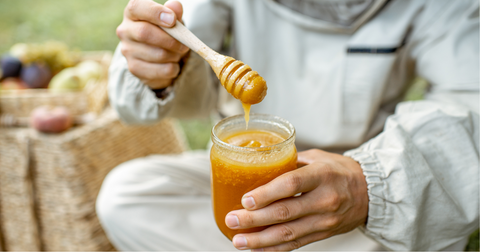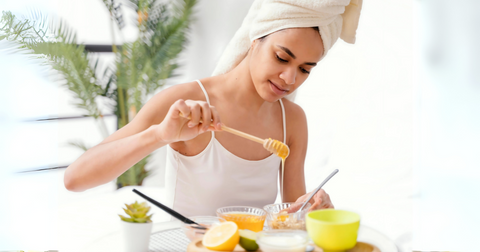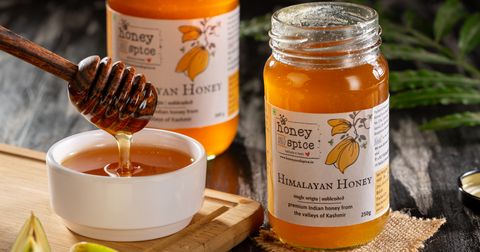Honey, a golden elixir loved for its sweetness and health benefits, sometimes it can also surprise us with a change in transformation.
If you've noticed your honey turning thick and grainy texture, it’s due to crystallization. We’ll talk about the reasons behind this natural process and provide simple methods to return your honey so you can enjoy its smooth, liquid form again.

Why Does Honey Crystallize?
Honey crystallization is a natural process that occurs due to Honey’s unique chemical composition. It is the formation and growth of sugar crystals in a jar of Honey.
Crystallization is a natural process and not a sign of adulteration or spoilage.
It’s not a sign of spoilage but a normal reaction to honey’s supersaturated sugar solution. Here are the key factors influencing crystallization
# Sugar Content
One of the main reasons why Honey crystallizes is its sugar content, specifically the balance between glucose and fructose.
Honey’s balance of glucose and fructose affects its crystallization. Honey with more glucose crystallizes faster, while higher fructose content slows it down.
# Temperature
Another significant reason for Honey crystallization is the temperature at which Honey is stored.
Honey stored at cooler temperatures (below 10°C) crystallizes faster. Conversely, higher temperatures (above 25°C) can affect honey quality, so the best storage is at room temperature (20-25°C).
Cooler temperatures accelerate crystallization. Honey stored in a refrigerator will crystallize faster than when kept at room temperature.
The best and ideal place to store the Honey is at room temperature.
# Pollen and Particles
Pollen and other tiny particles suspended in Honey act as catalysts for crystallization. These particles provide nucleation sites where sugar molecules can begin to align and form crystals.
Essentially, these particles speed up the natural crystallization process by offering starting points for crystal growth.
While pollen and particles contribute to the process, they are not the sole determinants of crystallization the ratio of glucose to fructose in the Honey and storage temperature play equally important roles.
Honey crystallizes because of tiny things like pollen and dust in it. These act like starting points for sugar to turn into crystals. It's like snowflakes forming around dust particles in the air.
Is It Okay to Eat Honey That Has Crystallized?
Absolutely! Crystallized Honey is perfectly safe to eat. Crystallization does not affect Honey’s flavour or nutritional value.
The beneficial properties, such as vitamins, minerals, and antioxidants, remain intact. While just the texture is different, the taste and health benefits remain the same.
Crystallized Honey can even be a delightful addition to your kitchen. Its thick texture makes it an excellent spread for toast or an ingredient for baking also can be added to smoothies as a substitute for sugar.
You can also dissolve it in hot beverages or use it in recipes where it is suitable.
Does Fake Honey Crystallize?
Generally, no, fake Honey doesn't crystallize. One of the hallmarks of genuine Honey is its tendency to crystallize over time. Fake or adulterated Honey, often diluted with sugar syrups or high-fructose corn syrup, may not crystallize or may do so differently. The absence of crystallization can sometimes be an indicator of Honey that is not pure.
100% Pure Honey, like from Honey & Spice, crystallizes naturally as it ages, reflecting its purity and quality. Our Honey is 100% natural and sourced from pristine forests of different regions across India.
How Do You Stop Honey from Crystallizing?
While you can’t completely prevent crystallization, you can take steps to delay the process of crystallization:
# Container
Store Honey in a tightly sealed glass jar, or airtight container to prevent exposure to air and moisture, which can delay the process of crystallization and affect its quality.
That's why at Honey and Spice, we specifically use airtight glass jars to ensure the honey stays fresh and retains all its natural goodness.

# Storage
Store Honey in a cool, dark place to preserve its quality and extend its shelf life.
Avoid placing the jar near high-temperature areas, such as close to a stove or oven, as heat can accelerate crystallization and degrade the Honey's beneficial properties.
# Temperature
To minimize crystallization, avoid storing Honey in temperatures below 50°F (10°C), as cooler conditions can cause the Honey to crystallize more quickly.
The best storage temperature for Honey is at room temperature, where it can maintain its smooth, liquid consistency for a longer period.
How to Liquify Honey that has Crystalized
# Warm water bath
Place the sealed Honey jar in a bowl of warm water. The gentle warmth will gradually dissolve the sugar crystals, restoring the Honey to its liquid state. Patience is key here; rushing the process with excessively hot water can diminish the Honey's delicate flavour and nutritional profile.

Embrace the Sweetness of Honey
Honey crystallization is a natural process that reflects the purity and authenticity of this golden elixir. Far from being a flaw, crystallization is a sign that your Honey is genuine, unprocessed, and full of natural goodness.
By understanding why Honey crystallizes and how to manage it, you can continue to enjoy its sweetness and health benefits in every form. Whether you prefer it smooth or spreadable, it remains a versatile and nutritious addition to your kitchen.
At Honey & Spice, we take pride in offering 100% pure, natural jars of Honey sourced from the pristine forests across India. Embrace the true essence of Honey by exploring our diverse collection, and experience the rich flavours and health benefits that only pure Honey can offer. Visit our website today to discover more about our products and bring home the taste of nature's finest.







